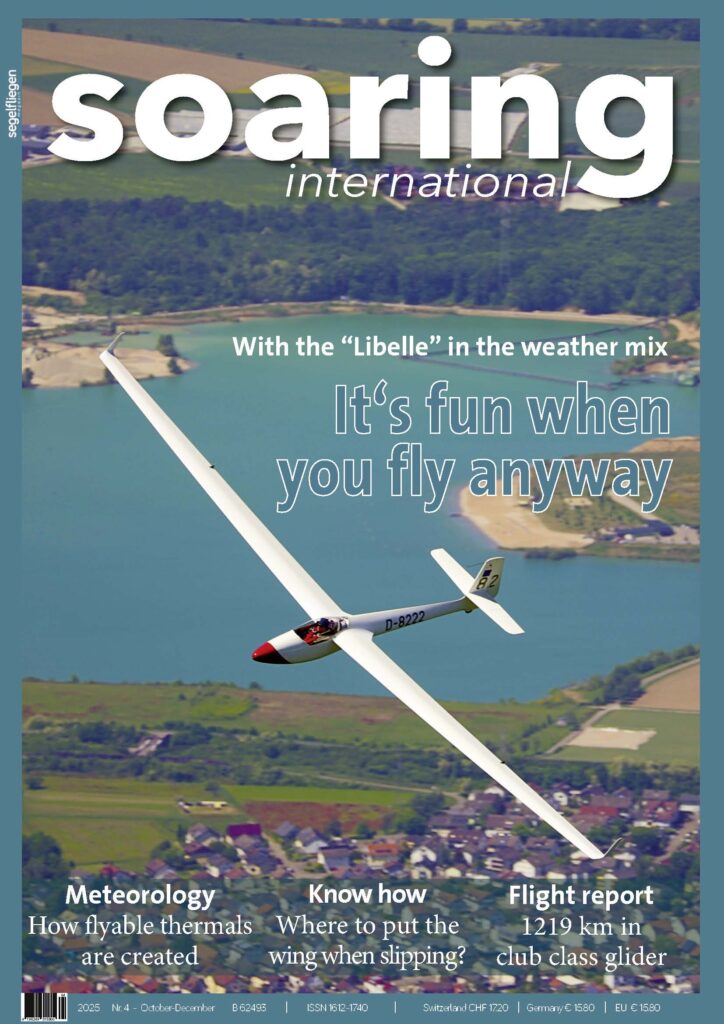
Here it is, our latest issue! Once again, we have put together a colorful selection of exciting, fascinating, and informative articles for you. These include some fantastic cross-country flights: with a Libelle in mixed weather, 1,200 kilometers with a club-class glider, a road movie with the Stemme, and a daring flight with the ASK 18. Our Sposos also report on their summer of performance flying, our meteorologist explains how workable thermals are created, you will learn where the wing should point during a slip and how wind influences an optimized winch launch. A pilot whose accident ended without serious consequences reports on how important it is to assess the terrain, especially in the mountains. Our oldie fans can look forward to the Skylark “Feldlerche”, which is becoming a star as an oldie, and those who enjoy reading about history will be taken back to the beginnings of the motor glider era and the long road to the B13e turbo-electric glider. Of course, there is also news, including the successor to Easy Memory and the IRIS All-in-one from LX Navigation. And finally, something to dream about, a visit to a gliding painter.
So, now let’s get to the current issue!
And now let’s have a look into the current issue:

757 miles with the LS 1 – two years ago, that was unthinkable for me. Now it‘s reality. But let’s start at the beginning.
It‘s a normal day at university. I‘m sitting in the lecture hall, feeling a little bored, and scrolling through the weather maps for the coming week. My mood slowly lifts when I see that in a few days, a cold front will move southward from a low-pressure system over Great Britain, heading almost directly toward Biscay. In the Northern Alps, that means a day of foehn winds is on the way! And in April, that means the days are already significantly longer than in fall or spring, when statistically most Föhn conditions occur. I analyze further weather models and they all agree: there will be Föhn on Tuesday and Wednesday.
The next lecture starts, but I can‘t get the idea out of my head. I start planning in my mind. A day off requires some logistical planning. The first problem is finding the time, which means no exams, no mandatory internships, and no important events on that day. Luckily, Easter and the Easter semester break are just around the corner, so I‘m sure to have time. You also need an aircraft that is equipped to fly in a jet stream, i.e., with an oxygen system and transponder.
Fortunately, I have been the proud owner of an LS 1-f neo, the “8Y,” for several years now, which meets all my requirements. The only drawback is that it is a club class aircraft, built in 1974. It has no water ballast, no flaps, and the yellow zone starts at 92 kt (170 km/h), which can be a problem with wind speeds of up to 65 kt (120 km/h) and the strong turbulence that can be expected. And last but not least, you also need an airfield from which to take off. I use Unterwössen for this, from where I can be sure to be in the air by 7 a.m.
The plan
As the days pass, Wednesday emerges as the most likely best day. In the morning, the wind field should be far enough east to be reachable from Unterwössen. In the east itself, the wind will not pick up until late afternoon, but good thermals are expected to set in from 12:00 noon. Experience has shown that the combination of wind and thermals is particularly good, as the thermals adjust the air stratification so that the wind does not flow around the mountains, but over them. In addition, the wind organizes the thermal detachments on the windward slopes of the mountains, creating a race track, especially on the long southern slopes of the Kalkalpen in the east.
The plan is therefore to make the first turn as far west as possible. On the one hand, this has the advantage that the tailwind leg back towards the east becomes longer, and on the other hand, I will arrive at the slope lines just in time for the start of the thermals. The next turn should then be as far east as possible in order to re-enter the wave system of the main ridge, which will then be in the wind field, so as to be independent of the end of the thermals. My PC ultimately shows 673 miles (1,083 km) over three turning points, which should be possible!
The flight
7:04 a.m., I‘m sitting in the plane, the tow plane tightens the rope, and we‘re off! (…)
What happens next? Read the full article in the current issue.

